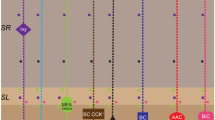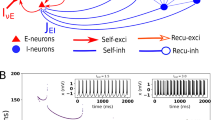Abstract
An important step in visual processing is the segregation of objects in a visual scene from one another and from the embedding background. According to current theories of visual neuroscience, the different features of a particular object are represented by cells which are spatially distributed across multiple visual areas in the brain. The segregation of an object therefore requires the unique identification and integration of the pertaining cells which have to be “bound” into one assembly coding for the object in question. Several authors have suggested that such a binding of cells could be achieved by the selective synchronization of temporally structured responses of the neurons activated by features of the same stimulus. This concept has recently gained support by the observation of stimulus-dependent oscillatory activity in the visual system of the cat, pigeon and monkey. Furthermore, experimental evidence has been found for the formation and segregation of synchronously active cell assemblies representing different stimuli in the visual field. In this study, we investigate temporally structured activity in networks with single and multiple feature domains. As a first step, we examine the formation and segregation of cell assemblies by synchronizing and desynchronizing connections within a single feature module. We then demonstrate that distributed assemblies can be appropriately bound in a network comprising three modules selective for stimulus disparity, orientation and colour, respectively. In this context, we address the principal problem of segregating assemblies representing spatially overlapping stimuli in a distributed architecture. Using synchronizing as well as desynchronizing mechanisms, our simulations demonstrate that the binding problem can be solved by temporally correlated responses of cells which are distributed across multiple feature modules.
Similar content being viewed by others
References
Abeles M (1982) Local cortical circuits. An electrophysiological study. Springer, Berlin Heidelberg New York
Ballard DH, Hinton GE, Sejnowski TJ (1983) Parallel visual computation. Nature 306:21–26
Barlow HB (1972) Single units and sensation: a neuron doctrine for perceptual psychology. Perception 1:371–394
Crick F (1984) Function of the thalamic reticular complex: the searchlight hypothesis. Proc Natl Acad Sci USA 81:4586–4590
Damasio AR (1989) The brain binds entities and events by multiregional activation from convergence zones. Neural Comp 1:123–132
Eckhorn R, Bauer R, Jordan W, Brosch M, Kruse W, Munk M, Reitboeck HJ (1988) Coherent oscillations: a mechanism of feature linking in the visual cortex? Biol Cybern 60:121–130
Eckhorn R, Reitboeck HJ, Arndt M, Dicke P (1990) Feature linking via synchronization among distributed assemblies: simulations of results from cat visual cortex. Neural Comp 2:293–307
Engel AK, König P, Kreiter AK, Singer W (1991a) Inter-hemispheric synchronization of oscillatory neuronal responses in cat visual cortex. Science 252:1177–1179
Engel AK, Kreiter AK, König P, Singer W (1991b) Synchronization of oscillatory neuronal responses between striate and extrastriate visual cortical areas of the cat. Proc Natl Acad Sci USA 88:6048–6052
Engel AK, König P, Singer W (1991c) Direct physiological evidence for scene segmentation by temporal coding. Proc Natl Acad Sci USA 88:9136–9140
Engel AK, König P, Kreiter AK, Schillen TB, Singer W (1992a) Temporal coding in the visual cortex: new vistas on integration in the nervous system. Trends Neurosci 15:218–226
Engel AK, König P, Schillen TB (1992b) Why does the cortex oscillate? Curr Biol 2:332–334
Essen DC van, Maunsell JHR (1983) Hierarchical organization and functional streams in the visual cortex. Trends Neurosci 6:370–375
Felleman DJ, Essen DC van (1991) Distributed hierarchical processing in the primate cerebral cortex. Cerebral Cortex 1:1–47
Freeman WJ (1975) Mass action in the nervous system. Academic, New York
Gray CM, Singer W (1987) Stimulus-specific neuronal oscillations in the cat visual cortex: a cortical functional unit. Soc Neurosci Abstr 13:404.3
Gray CM, Singer W (1989) Stimulus-specific neuronal oscillations in orientation columns of cat visual cortex. Proc Natl Acad Sci USA 86:1698–1702
Gray CM, König P, Engel AK, Singer W (1989) Oscillatory responses in cat visual cortex exhibit inter-columnar synchronization which reflects global stimulus properties. Nature 338:334–337
Hebb DO (1949) The organization of behavior. Wiley, New York
Horn D, Sagi D, Usher M (1991) Segmentation, binding, and illusory conjunctions. Neural Comp 3:510–525
Innocenti GM (1980) The primary visual pathway through the corpus callosum: morphological and functional aspects in the cat. Arch Ital Biol 118:124–188
Julesz B (1981) Textons, the elements of texture perception and their interaction. Nature 290:91–97
Kammen DM, Holmes PJ, Koch C (1989) Origin of oscillations in visual cortex: feedback versus local coupling. In: Cotterill RMJ (eds) Models of brain function. Cambridge University Press, Cambridge, UK, pp 273–284
König P. Schillen TB (1991) Stimulus-dependent assembly formation of oscillatory responses. I. Synchronization. Neural Comp 3:155–166
Kreiter A, Singer W (1992) Oscillatory neuronal responses in the visual cortex of the awake macaque monkey. Eur J Neurosci 4:369–375
Livingstone MS (1991) Visually-evoked oscillations in monkey striate cortex. Soc Neurosci Abstr 17:73.3
Livingstone MS, Hubel D (1988) Segregation of form, color, movement, and depth: anatomy, physiology, and perception. Science 240:740–749
Malsburg C von der (1981) The correlation theory of brain function. (Internal report 81–2) Max Planck Institute for Biophysical Chemistry, Göttingen
Malsburg C von der (1986) Am I thinking assemblies? In: Palm G, Aertsen A (eds) Brain theory. Springer, Berlin Heidelberg New York, pp 161–176
Malsburg C von der, Buhmann W (1992) Sensory segmentation with coupled neural oscillators. Biol Cybern 67:233–242
Milner PM (1974) A model for visual shape recognition. Psychol Rev 81:521–535
Murthy VN, Fetz EE (1992) Coherent 25–35 Hz oscillations in the sensorimotor cortex of the awake behaving monkey. Proc Natl Acad Sci USA 89:5670–5674
Neuenschwander S, Varela FJ (1990) Sensory-triggered oscillatory activity in the avian tectum. Soc Neurosci Abstr 16:47.6
Niebur E, Schuster HG, Kammen DM (1991) Collective frequencies and metastability in networks of limit-cycle oscillators with time delay. Phys Rev Lett 67:2753–2756
Schillen TB (1991a) Designing a neural network simulator — The MENS modelling environment for network systems I. Comp Appl Biosci 7:417–430
Schillen TB (1991b) Designing a neural network simulator — The MENS modelling environment for network systems II. Comp Appl Biosci 7:431–446
Schillen TB, König P (1991a) Stimulus-dependent assembly formation of oscillatory responses. II. Desychronization. Neural Comp 3:167–177
Schillen TB, König P (1991b) Temporal coding by coherent oscillations as a potential solution to the binding problem: neural network simulations. In: Schuster HG (eds) Nonlinear Dynamics of Neural Networks. VCH, Weinheim, pp 153–172
Schuster HG, Wagner P (1989) Mutual entrainment of two limit cycle oscillators with time delayed coupling. Prog Theor Phys 81:939–945
Shimizu H, Yamaguchi Y, Tsuda I, Yano M (1986) Pattern recognition based on holonic information dynamics: towards synergetic computers. In: Haken H (eds) Complex systems — operational approaches. Springer, Berlin Heidelberg New York, pp 225–240
Singer W, Artola A, Engel AK, König P, Kreiter AK, Löwel S, Schillen TB (1992) Neuronal representations and temporal codes. In: Poggio T, Glaser D (eds) Exploring brain functions: models in neuroscience. Wiley, New York
Sompolinsky H, Golomb D, Kleinfeld D (1990) Global processing of visual stimuli in a neural network of coupled oscillators. Proc Natl Acad Sci USA 87:7200–7204
Sporns O, Gally JA, Reeke Jr GN, Edelman GM (1989) Reentrant signaling among simulated neuronal groups leads to coherency in their oscillatory activity. Proc Natl Acad Sci USA 86:7265–7269
Sporns O, Tononi G, Edelman GM (1991) Modeling perceptual grouping and figure-ground segregation by means of active reentrant connections. Proc Natl Acad Sci USA 88:129–133
Treisman AM, Gelade G (1980) A feature-integration theory of attention. Cogn Psychol 12:97–136
Wilson MA, Bower JM (1991) A computer simulation of oscillatory behaviour in primary visual cortex. Neural Comp 3:498–509
Wilson MA, Cowan JD (1973) A mathematical theory of the functional dynamics of cortical and thalamic nervous tissue. Kybernetik 13:55–80
Zeki SM (1988) The functional logic of cortical connections. Nature 335:311–317
Author information
Authors and Affiliations
Rights and permissions
About this article
Cite this article
Schillen, T.B., König, P. Binding by temporal structure in multiple feature domains of an oscillatory neuronal network. Biol. Cybern. 70, 397–405 (1994). https://doi.org/10.1007/BF00203232
Received:
Accepted:
Issue Date:
DOI: https://doi.org/10.1007/BF00203232




